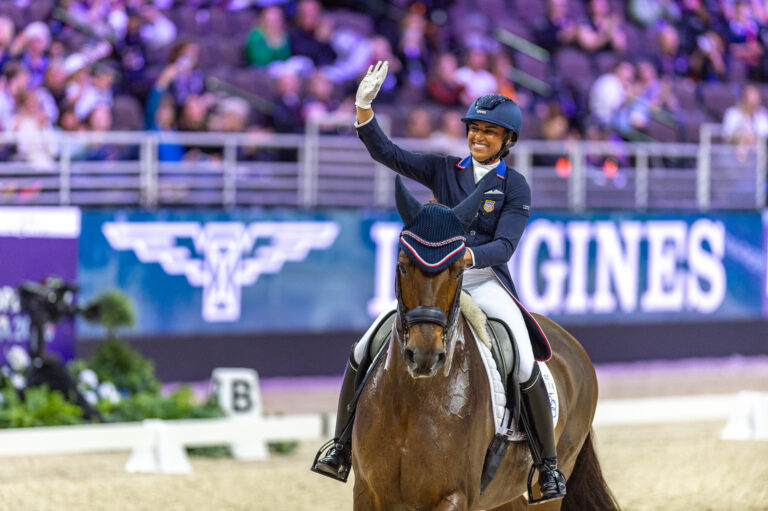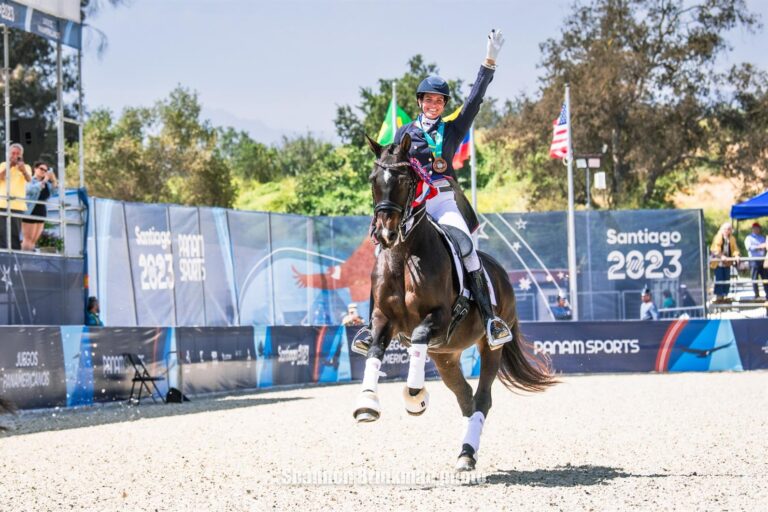March 27, 2015— “It’s week 12.”
That’s a commonly heard phrase here, used as a reply to a variety of comments and questions, echoed over the last few days at what is in effect the world’s longest horse show.
Is your performance not up to snuff?
“It’s week 12.”
Are you feeling a little worn around the edges?
“It’s week 12.”
The Adequan Global Dressage Festival and its sister Winter Equestrian Festival jumper, hunter and equitation classes a half-mile away at the Palm Beach International Equestrian Center are drawing to a close after three months of intense competition.
At AGDF, where I’ve been focusing my attention until tomorrow’s show jumping finale, the Nations’ Cup has taken center stage. The AGDF keeps breaking records, and this week’s show—with more than 300 rides—is the largest dressage competition ever held in the Western Hemisphere. The same was said of the 4- and 5-star shows presented earlier in the season, but the AGDF doesn’t stand on its laurels and simply continues to grow.
There was a special demand at the higher levels this week, because teams are getting ready for July’s Pan American Games, just outside of Toronto, and where better to practice or look at the potential of horse/rider combinations than at AGDF? As will be the case at the Pan Ams, squads were allowed to include both riders competing in Prix St. Georges/Intermédiaire I and Grand Prix/Grand Prix Special. The latter got an extra 1.5 percent bonus in their scores when adding up the team totals.
Central and South America are still developing in dressage, and no one from those regions competed in the Grand Prix portion of the Cup. Only Venezuela and Colombia fielded teams, as opposed to individuals, and the Venezuelan team was eliminated with just one rider finishing the competition.
While U.S. coach Robert Dover wants to see AGDF Nations’ Cup competition become strictly Grand Prix, Thomas Baur—who runs the sport end of AGDF—doesn’t believe it’s quite the right time.
“The reality is much different. I think we have to give them a couple of more years,” he pointed out. And that also applies to the Pan Ams, which used to be run strictly at Small Tour, despite being an Olympic qualifying competition.
In any case, no entry from south of the border broke 68 percent at Small Tour here. There was representation from Guatamala, Chile, the Dominican Republic, Puerto Rico and Brazil, as well as Venezuela and Colombia, while we also saw squads from Germany and Australia, and two-team powerhouses from the U.S. and Canada.
Robert has been bursting to the level of “goosebumps” at the performances of his squads. As expected, the members of Team 1—Kim Herslow (Rosmarin) and Olivia Lagoy-Weltz (Rassing’s Lonoir) at Small Tour, with Laura Graves (Verdades) and Allison Brock (Rosevelt) at Big Tour ended up with the gold medals around their necks.
But he took special care to mention the performance of the three-member Team 2. Tina Konyot had been scheduled to compete with Wyoming, but the horse was withdrawn for veterinary reasons and Shelley Francis bowed out with Danilo because she felt he had done enough this circuit, I was told. Tina was replaced by Chris Hickey (Ronaldo) who joined Kasey Perry (Goerklintgaard’s Dublet) and Catherine Haddad-Staller (Mane Stream Hotmail.)
Robert also gave credit to Developing Dressage Coach Debbie McDonald, noting at one point that they were “joined at the hip.” I glanced over at the two of them watching Laura’s ride and saw Debbie, sitting on a fence, tensely clutching Robert’s shoulder as the test unfolded.
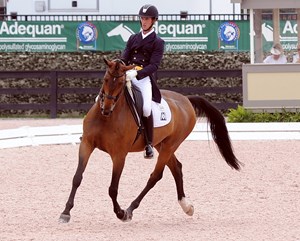
I told Debbie I admired her absolute dedication and she said, “I’m so invested in these guys,” meaning every member of the USA’s squads. Robert also cited the contributions of veterinary and administrative help.
USA Team 1 earned 452.599 percent, followed by Canada’s Teams 1 and 2, 438.966 and 424.774 respectively. USA Team 2 was close on 424.221, while Germany wound up with 420.509.
The U.S. performance boded well for America’s chances at the Pan Ams, where only the winning team qualifies for the Olympics next year in Rio.
That saddens Robert.
“I have voiced this many times already, but it will be to the detriment of our sport if both Canada and America are not able to compete as teams in Rio,” said Robert, who coached the Canadians before taking over his U.S. duties after the 2012 Olympics.
“Once they were with an average of 70 percent at the (2014) World Equestrian Games, it should have been an absolute that all those teams that were so wonderful at the WEG, that would have been the best way to determine that,” he pointed out. The U.S. was fourth there, but only the top three qualified for Rio.
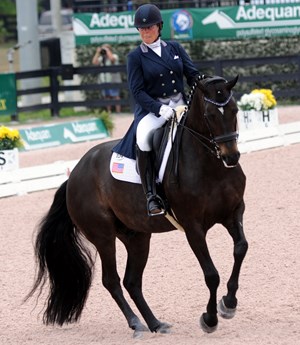
In a conversation earlier in the week, Robert told me “We still see how Eurocentric the sport is and how it continues — regardless of the world becoming flatter — in a way that is biased toward those in Western Europe.”
At the same time, he added, “I feel excellent about our Pan American chances and our chances in Rio. We have now truly awesome combinations. The growth of our country in the whole scheme of things is palpable to me.”
Kim earned a personal best in the I-1 and the highest score of the competition with 76.158 percent for a test in which her reliable mount, nicknamed Reno, reacted in such a businesslike way that I wouldn’t have been surprised to see him carrying a briefcase.
Kim and I talked about that performance.
Canadian Chris von Martels was second in the I-1 with the lithe Zilverstar, followed by veteran Christilot Boylen (Donatella) and Diane Creech (Robbie W), showing that they are coming up in the world.
The highest score in the Prix St. Georges belonged to Kasey from USA Team 2. She’s a 27-year-old Californian. Her mount with the tongue-twisting name is a bit of a firecracker, but she rides him to an impressive level. She majored in business entrepreneurship in college, but right now, she’s focusing on her riding. Watch this video to learn a little about her. Oh, and in the video I said WEF, when I meant AGDF. Give me a break; it’s Week 12.
Another hot horse is Rassing’s Lonoir, but he’s so graceful, he flows like melting chocolate (an especially apt comparison, since it has been so hot here.)
Before the Prix St. Georges, he lit up going into the ring, and made a few mistakes as a result. He has stopped the whinnying that used to characterize his tests, and is finding other ways to express himself. (Go to facebook.com/dressagetoday for visual evidence.)
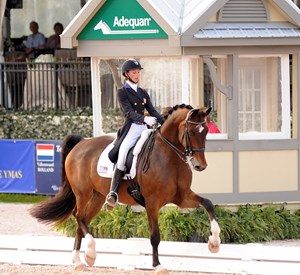
Olivia is such a wonderful rider, though, when Lono acted up going across the diagonal in the I-1, she stuck with him and then transitioned into the next movement as if nothing had happened. That’s riding! And she still earned 71.368 percent.,
Laura Graves, accompanied by her impish four-month old chihuahua/terrier cross, Stanley, looked so relaxed before getting ready to ride. I can see where she has confidence in Diddy, as she calls the horse her family bought as a weanling.
In the Special, she was marked at 75.882 percent, despite an oops in the one-tempis up the centerline at the end. Robert praised Diddy’s gaits from that performance, but always humble Laura cited others as she talked about her days here.
“It’s been an amazing experience, the opportunity to get to know some of the other American riders,” she commented, mentioning the many facets of the word “team.”
“It starts at a small level, between you and your horse. Then you have your barn staff, family and friends. then you have our amazing coaches,” she continued, going on to mention Stillpoint and Adequan while emphasizing the importance of sponsors.
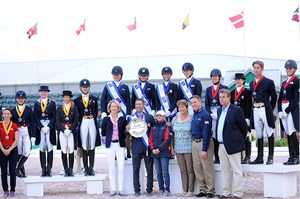
Diddy is a work in progress, and while Laura has come a long way with him, she wants to go even further.
“I’m still kind of figuring out how to ride my horse, even though I’ve trained him his entire life,” she smiled.
“Sometimes it’s figuring out where to put your leg on, when to put your leg on, how to put your leg on…all these these things…that make such a big difference, especially in a Grand Prix horse.”
I caught Robert just after the medal presentation to get his reaction to everything. You can see in the background of this video the hustle and bustle (and hear the music) that is part of such a big competition.
He has the right to be very excited, because now the U.S. has four star combinations at Grand Prix, with scores ranging from more than 74 percent to more than 80 percent. In addition to Steffen Peters’ mounts, Legolas and Rosamunde, who remained in California this week, the U.S. is fielding Verdades and Rosevelt, so the country is getting some depth
The good news for the U.S. effort this week didn’t stop at the medals. Claudine and Fritz Kundrun were saluted with champagne at the announcement of the Dressage Challenge.
They are giving $500,000 to the U.S. Equestrian Team Foundation, which funds high-performance sport, with that figure to be matched by other contributors. Bonnie Jenkins, the foundation’s executive director, said they are well on their way.
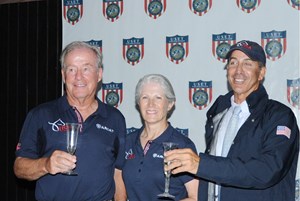
You remember the Kundruns from Flim-Flam, their Olympic and WEG horse ridden by Sue Blinks, but they also own Rosevelt, who is really coming into his own.
The Kundruns haven’t limited their generosity to the world of competition. While traveling in Pakistan for business years ago, Fritz was appalled at the conditions facing donkeys and horses in the third world. He and his wife have been big contributors to The Brooke (thebrooke.org), a charity that serves horses, donkeys and mules in poor communities around the world.
Fritz makes sure his money is going for a specific project. One such cause is an effort in Ethiopia, where he said donkeys laden to the gills stand in the sun for hours at the market before they are unloaded. Through the Brooke, shade is provided to the animals, as well as water. Things we take for granted are not even considered basics in those parts of the world, so the Kundruns deserve a huge salute for their welfare initiatives (Claudine also is involved in the Virginia Equine Welfare Society at home.)
On Sunday morning, look for my postcard on the Suncast and Rolex show jumping grands prix. In the meantime, check out facebook.com/dressagetoday for more photos.
Follow the links below to all of the final results
• Grand Prix and Prix St. Georges CDIO3*
• Intermediaire I and Grand Prix Special CDIO3*
Until then,

https://content.jwplatform.com/players/vOnnr9cT-eWne0cbv.htmlhttps://content.jwplatform.com/players/4w8ZvskB-eWne0cbv.htmlhttps://content.jwplatform.com/players/QF0kgCba-eWne0cbv.html




